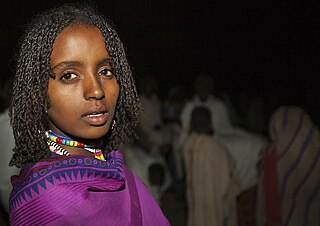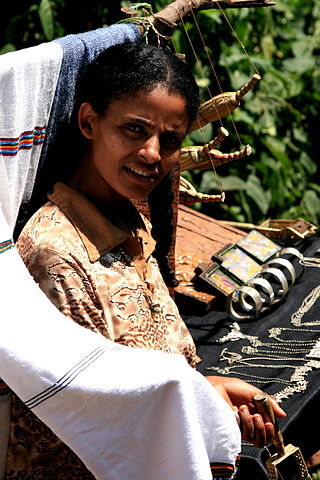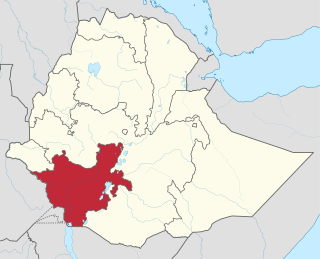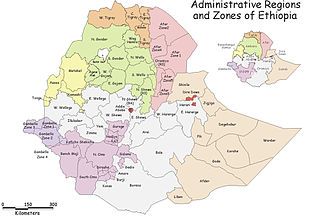Sources
- Azeb Amha and Dirk Bustorf: "Basketo". In: Encyclopaedia Aethiopica. vol. 1. Wiesbaden 2003. pp. 499f.
- Eike Haberland: "Die Basketto und verwandte Stämme". In: Altvölker Süd-Äthiopiens. Stuttgart 1959. pp. 189–226.
The Basketo people are an Omotic-speaking ethnic group whose homeland lies in the northwestern part of the South Ethiopia Regional State (SERS) of Ethiopia. The Basketo Zone is named after this ethnic group. According to the 2007 Ethiopian national census, this ethnic group has 78,284 members, of whom 99.3% live in the SNNPR. [1]
The Basketo cultivate ensete and, additionally, tuber roots, maize, millet and vegetables. They also keep domestic animals in small numbers.
Traditionally, the Basketo were organized as a segmentary clan society headed by a divine king, the kati. The ethnic religion of the Basketo knew a duality of the sky-god Tsosii and the earth-mother Qacharunde. When they were united with the other ethnic groups by King Menilik II in 1893 many of them converted to Ethiopian Orthodox Christianity.
The Basketo were conquered for the Ethiopian empire by Ras Welde Giyorgis in 1893.[ citation needed ]

The Oromo people are a Cushitic ethnic group native to the Oromia region of Ethiopia and parts of Northern Kenya. They speak the Oromo language, which is part of the Cushitic branch of the Afroasiatic language family. They are one of the largest ethnic groups in Ethiopia. According to the last Ethiopian census of 2007, the Oromo numbered 25,488,344 people or 34.5% of the Ethiopian population. Recent estimates have the Oromo comprising 45,000,000 people, or 35.8% of the total Ethiopian population estimated at 116,000,000.

Amharas are a Semitic-speaking ethnic group which is indigenous to Ethiopia, traditionally inhabiting parts of the northwest Highlands of Ethiopia, particularly inhabiting the Amhara Region. According to the 2007 national census, Amharas numbered 19,867,817 individuals, comprising 26.9% of Ethiopia's population, and they are mostly Oriental Orthodox Christian.

The Southern Nations, Nationalities, and Peoples' Region was a regional state in southwestern Ethiopia. It was formed from the merger of five kililoch, called Regions 7 to 11, following the regional council elections on 21 June 1992. Its government was based in Hawassa.

Jijiga is the capital city of Somali Region, Ethiopia. It became the capital of the Somali Region in 1995 after it was moved from Gode. Located in the Fafan Zone with 70 km (37 mi) west of the border with Somalia, the city has an elevation of 1,634 metres above sea level. Jigjiga is traditionally the seat of the Bartire Garad Wiil-Waal of the Jidwaaq Absame. The International airport is named after him.

Wag Hemra is a Zone in the Amhara Region of Ethiopia. Its name is a combination of the former province of Wag, and the dominant local ethnic group, the Kamyr Agaw. Wag Hemra is bordered on the south by Semien Wollo, on the southwest by Debub (South) Gondar, on the west by Semen (North) Gondar, and on the north and east by the Tigray Region. Towns in Wag Hemra include Soqota.

North Omo Zone was a zone in the Southern Nations, Nationalities, and Peoples' Region of Ethiopia. It was named after the Omo River, which flows in the western area of the former zone. In 2000 it was split into three zones: Dawro, Gamo Gofa, and Wolayita; and Basketo and Konta became special woredas.
SekotaZuria is one of the woredas in the Amhara Region of Ethiopia. Located in the Wag Hemra Zone, Sekota is bordered on the south by Gazbibla, on the southwest by Dehana, on the west by Zikuala, on the north by Abergele, and on the east by the Tigray Region. The separate woreda of town of Soqota is surrounded by Sekota. Abergele woreda was separated from Sekota.
Hadiya, also spelled as Hadiyya, is an ethnic group native to Ethiopia in Southern Nations, Nationalities and Peoples' Region who speak the Hadiyyisa language. According to a popular etymology, the name 'Hadiyya," means gift of god". it is mainly known for it's islamic influences in southern partof south shewa and west sharka A historical definition of the Hadiya people based on the old Hadiyya Sultanate included a number of Ethiopian ethnic groups currently known by other names. Currently, this historic entity is subdivided into a number of ethnonyms, partly with different languages and cultural affiliations. In his book "A History of the Hadiyya in Southern Ethiopia," Ulrich Braukämper reported that Leemo, Weexo-giira, Sooro, Shaashoogo, Baadawwaachcho, and Libido (Maraqo) Hadiyya, Endegang subgroups remain a language entity and preserved identity of oneness, the Hadiyya proper. The term Hadiya specifically designates the Qabeena people. Other ethnic groups such as Siltʼe, Wulbareg, Azarnat, Barbare, Wuriro, Wolane and Gadabano profess that they're the seven Hadiya clans. Hadiya people were fully muslims until invasion of menilik II in 19th century that caused massive forced conversion to Christianity and increasing protestant missionaries in late 19s. Clans of Hadiya origin in Oromia, Sidama, Wolayta, Gurage, Tigray, and Afar were completely absorbed by these nations. They were initially all inhabitants of a single political entity, a sultanate, which in the four centuries following its break-up in the mid-16th century fragmented into separate ethnic groups.

Basketo Zone is a zone in the South Ethiopia Regional State of Ethiopia, named after its inhabitants, the Basketo people. It was formerly a part of the Southern Nations, Nationalities and Peoples' Region (SNNPR)'s, and included in to South Ethiopia Regional State in 2023 after a referendum.
Selamago is a woreda in the South Ethiopia Regional State. Part of the South Omo Zone, Selamago is bordered on the south by Nyangatom, on the west and north by the Omo River which separates it from the Bench Maji, Keffa and Konta, on the northeast by the Gamo Gofa, on the east by the Basketo and Bako Gazer, and on the southeast by the Usno River which separates it from Bena Tsemay; the Mago River defines part of the boundary with Bako Gazer. The administrative center of Selamago is Hana.
Bako Gazer is one of the woredas in the South Ethiopia Regional State. It is also called Southern Aari as it is part of the homeland of Aari people. Part of the Debub Omo Zone, Bako Gazer is bordered on the south by Bena Tsemay, on the west by the Mago River which separates it from Selamago, on the north by the Basketo special woreda and Gelila, on the northeast by the Gamo Gofa Zone, and on the east by Male. The administrative center of this woreda is Jinka; other towns in Bako Gazer include Tolta and Wub Hamer. Gelila and Male woredas were separated from Bako Gazer.
Melokoza is one of the woredas in the Southern Nations, Nationalities, and Peoples' Region of Ethiopia. Part of the Gamo Gofa Zone, Melokoza is bordered on the south by Basketo special woreda, on the southwest by the Debub (South) Omo Zone, on the northwest by the Konta special woreda, on the north by the Dawro Zone, and on the east by Demba Gofa and Geze Gofa; the Omo River defines its northwestern boundary separating the woreda from Konta and the Dawro Zone. The major town in Melokoza is Leha.
Kersana Malima or Kersa and Malima, is a Aanaa in Oromia, Ethiopia. Part of the Southwest Shewa Zone, Kersana Mailma is bordered on the south by the Southern Nations, Nationalities and Peoples Region, on the west by Kokir, on the northwest by Tole, on the northeast by Sebeta Hawas, and on the east by the East Shewa Zone; the Awash defines the boundary between this woreda and Alem Gena and the Misraq Shewa Zone. The major town in Kersana Malima is Leman. Sodo Dacha woreda was separated from Kersana Malima.
Degehabur is a town in the Ogaden Region of Ethiopia. It is located in the Jarar Zone of the Ogaden Region. Degehabur sits at 1044 meters above sea level. The town is the administrative center of Degehabur woreda.
Basketo is an Afro-Asiatic language spoken in the Basketo special woreda of the Southern Nations, Nationalities, and Peoples Region, which is part of Ethiopia. The speakers refer to the language as "Masketo", while their neighbors refer to it as "Basketo." It has said to consist of two dialects, "Doko" (Dokko) and "Dollo" (Dollo). Besides their mother tongue, some also speak Melo, Oyda, Galila, or Gofa.

Dizi is the name of an ethnic group living in southern Ethiopia. They share a number of somatic similarities with certain culturally related peoples of south-western Ethiopia, which include the Sheko and Nao, the Gimira, the Tsara, the Dime, the Aari and certain sub-groups of the Basketo people. A. E. Jensen has gathered these groups under the label of the "ancient peoples of southern Ethiopia". They speak the Dizin language.
Gamo Zone is a zone in the South Ethiopia Regional State of Ethiopia. Gamo is bordered on the south by the Dirashe special woreda, on the southwest by Debub (South) Omo and the Basketo special woreda, on the northwest by Konta special woreda, on the north by Dawro and Wolayita, on the northeast by the Lake Abaya which separates it from the Oromia Region, and on the southeast by the Amaro special woreda. The administrative center of Gamo is Arba Minch.
Gelila is one of the woredas in the Southern Nations, Nationalities, and Peoples' Region of Ethiopia. It is also called Northern Aari as it is part of the homeland of Aari people. Part of the Debub Omo Zone, Gelila is bordered on the south by Bako Gazer, on the north by the Basketo special woreda, and on the east by the Gamo Gofa Zone. Gelila was separated from Bako Gazer woreda.
Maale is one of the woredas in the South Ethiopia Regional State. It is named after the Maale people who are living at this woreda. Part of the Debub Omo Zone, Male is bordered on the south by Bena Tsemay, on the west by Bako Gazer, on the north by the Basketo special woreda and Gelila, on the north and east by the Gamo Gofa Zone, and the southeast by Dirashe special woreda. The male was separated from Bako Gazer woreda.
Geze Gofa is a woreda (district) in the zone of Gofa Zuria in South Ethiopia Regional State in Ethiopia. Geze Gofa is bordered on the south by Oyda, on the west by Basketo Zone, on the northwest by Melokoza, and on the east by Demba Gofa. Towns in Geze Gofa include Bulki.